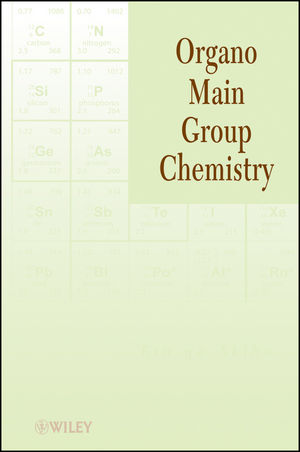Organo Main Group ChemistryISBN: 978-0-470-45033-8
Paperback
288 pages
August 2011
 This is a Print-on-Demand title. It will be printed specifically to fill your order. Please allow an additional 10-15 days delivery time. The book is not returnable.
|
||||||
1 Main Group Elements and Heteroatoms: Scope and Characteristics 1
1.1 Aufbau Principle and Sign of Orbitals / 1
1.2 Electronic Configuration of an Atom: Main Group Elements and Heteroatoms / 3
1.3 Fundamental Properties of Main Group Elements / 5
1.4 Acidity of Carboxylic Acid and Substituent Effect / 7
1.5 Heteroatom Effect / 10
1.5.1 Stabilization of α-Carbocation by Resonance: Stereoelectronic Effect / 10
1.5.2 Coordination with Lewis Acids / 15
References / 16
Notes 1: Electronegativity 17
Notes 2: Importance of Formal Logic-I: Oxidation Number and Formal Charge 19
Notes 3: Importance of Formal Logic-II: Octet Rule, Eighteen-Electron Rule, Hypervalence 23
2 Main Group Element Effect 25
2.1 What Is Main Group Element Effect? / 25
2.2 Single Bond Energy and π –Bond Energy / 27
2.3 Hypervalent Compound / 31
2.4 Effect of Hypervalent Bond (1): 3c–4e Bond and Structure / 33
2.5 Effect of Hypervalent Bond (2): Apicophilicity and Pseudorotation / 41
2.6 Effect of Hypervalent Bond (3): Ligand Coupling Reaction (LCR) and Edge Inversion / 45
2.7 Effect of σX−C / 46
2.8 Effect of σ ∗ X−C / 48
Notes 4: (σ, σ ∗) and (π, π ∗): HMO (Hueckel Molecular Orbital) and Electrocyclic Reaction 57
3 Lithium, Magnesium, and Copper Compounds 63
3.1 Synthesis / 64
3.2 Structure / 66
3.3 Reaction / 68
3.3.1 Deprotonation as Base / 69
3.3.2 Nucleophilic Reaction / 72
3.3.3 Conjugate Addition of Lithium Dimethylcuprate / 76
References / 77
4 Boron and Aluminum Compounds 79
4.1 Synthesis / 80
4.2 Structure / 82
4.3 Reaction / 84
References / 88
5 Silicon, Tin, and Lead Compounds 91
5.1 Synthesis / 92
5.2 Reaction / 94
5.3 Organotin and Lead Compounds / 100
References / 104
Notes 5: Stable Carbene and Its Complex 105
6 Phosphorus, Antimony, and Bismuth Compounds 111
6.1 Phosphorus Compounds / 112
6.2 Synthesis of Organophosphorus Compounds / 113
6.3 Tertiary Phosphine and Its Nucleophilic Reaction / 115
6.4 Arbuzov Reaction / 117
6.5 Perkow Reaction / 118
6.6 Synthesis of Optically Active Phosphines / 119
6.7 Ylide and Wittig Reaction and Related Ones / 123
6.8 Reactions of Phosphonium Salts and Formation of Phosphoranes / 131
6.9 Freezing BPR and Its Effect / 138
6.10 Antimony and Bismuth Compounds / 143
References / 146
Notes 6: Dreams of Staudinger and Wittig 149
Notes 7: Stereochemistry in Nucleophilic Substitution of MX4-type Compounds: Inversion or Retention 155
7 Sulfur, Selenium, and Tellurium Compounds 159
7.1 Sulfur Compounds / 160
7.2 Synthesis of Organosulfur Compounds / 160
7.3 Reactions of Organosulfur Compounds / 166
7.4 Structure and Reaction of Hypervalent Organosulfur
Compounds / 170
7.5 Selenium and Tellurium Compounds / 175
References / 178
Notes 8: Inversion Mechanism of NH3 and NF3: Vertex Inversion or Edge Inversion 181
8 Organohalogen Compounds: Fluorine and Iodine Compounds 187
8.1 Synthesis of Chlorine and Bromine Compounds / 188
8.2 Fluorine Compounds / 190
8.3 Iodine Compounds / 195
References / 199
9 Atrane and Transannular Interaction: Formation of Hypervalent Bond 201
9.1 Introduction / 201
9.2 Silatrane and Atrane / 202
9.3 Transannular Interaction (1) / 208
9.4 Transannular Interaction (2) / 210
References / 211
10 Unsaturated Compounds of Main Group Elements of Third Period and Heavier 213
10.1 Introduction / 213
10.2 Unsaturated Bonds of Group 15 Elements of Third Period and Heavier / 215
10.3 Unsaturated Bonds of Group 14 Elements of Third Period and Heavier / 219
10.4 Aromatic Compounds of Group 14 Elements / 222
References / 223
11 Ligand Coupling Reaction 225
11.1 Introduction / 225
11.2 Selectivity of Ligand Coupling Reaction: Theoretical Investigation / 226
11.3 Ligand Coupling Reaction of Organic Compounds of Phosphorus, Antimony, and Bismuth / 227
11.4 Ligand Coupling Reaction of Organic Compounds of Sulfur, Selenium, and Tellurium / 237
11.5 Ligand Coupling Reaction of Organoiodine Compounds / 241
References / 245
Notes 9: Hexavalent Organotellurium Compounds 247
12 Hypervalent Carbon Compounds: Can Hexavalent Carbon Exist? 251
12.1 Introduction / 251
12.2 Attempts for Pentacoordinate Hypervalent Carbon Species / 253
12.3 Synthesis of Pentacoordinate Hypervalent Carbon Species (10-C-5) and Bond Switching at Carbon and Boron / 254
12.4 Attempts to Hexacoordinate Hypervalent Carbon Species (12-C-6) / 259
References / 262
Notes 10: Main Group Element Porphyrins 265
Index 269



